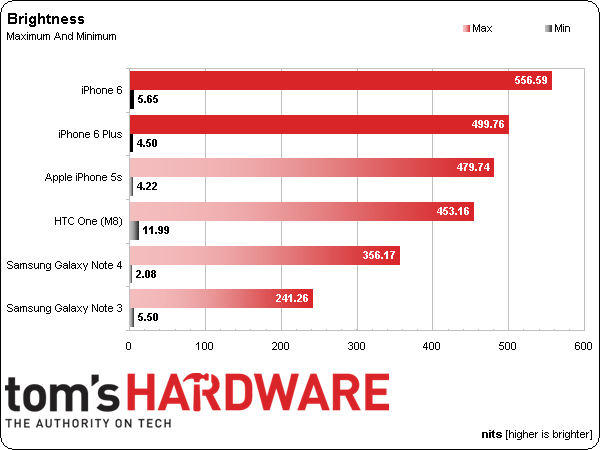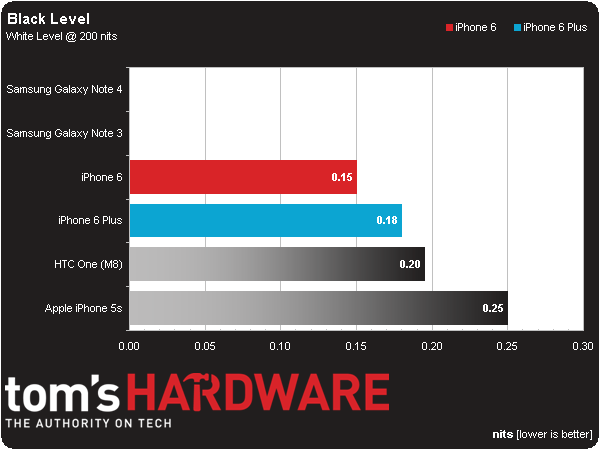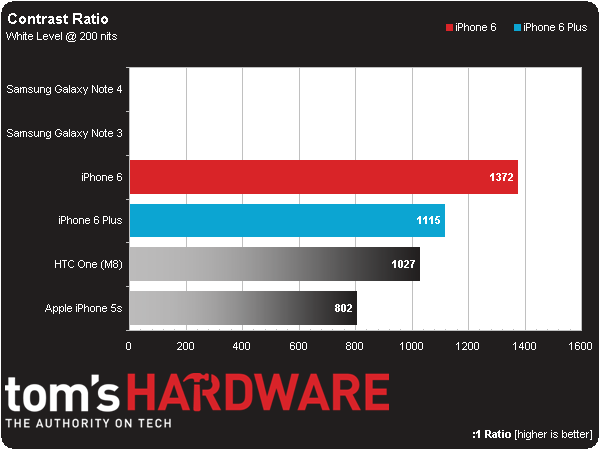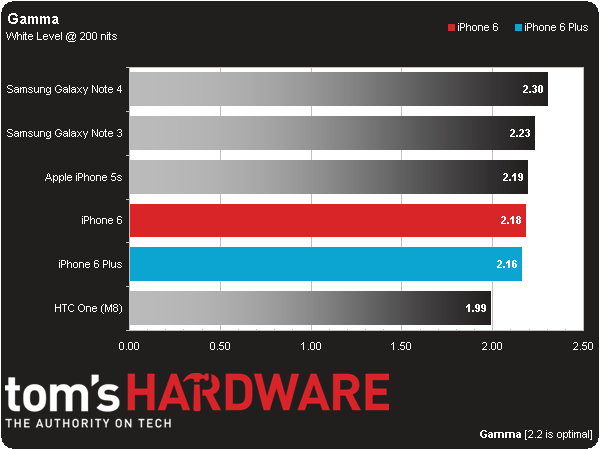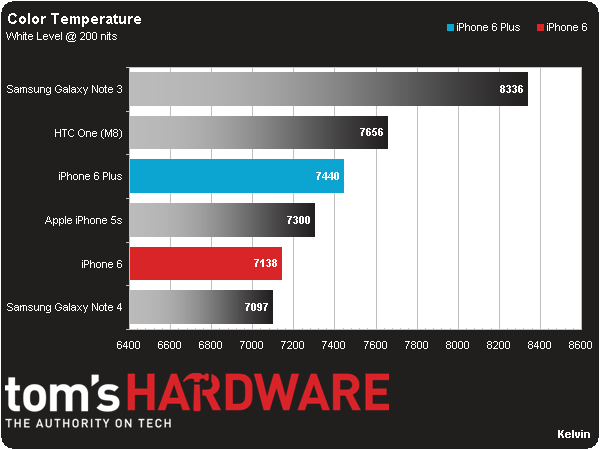Apple iPhone 6 And iPhone 6 Plus Review
The iPhone 6 and 6 Plus are bigger and better than ever, but are they a worthy upgrade for existing iPhone users? What if you previously passed over the iPhone because of its small screen, does it now merit a second look?
Why you can trust Tom's Hardware
Test Results: Display Measurements
Brightness
Brightness (also known as white level) measurements are taken by recording the luminance output of each device displaying a full white pattern, with the device's brightness slider set to both minimum and maximum values.
Max brightness for the iPhone 6 Plus is slightly higher than the 5s at 500 nits. The iPhone 6 is even brighter, making it easier to see in direct sunlight.
In order to make device comparison possible, the rest of our display measurements, along with our battery testing, are performed with the screen set to a standardized white level of 200 nits.
Black Level
Our black level measurement is the luminance output of a full black pattern after the luminance output of full white has been standardized to 200 nits. It's important to note that AMOLED displays will always measure a black level of zero, since their pixels simply turn off to render black.
The new Retina HD screen improves upon the already good black level of the iPhone 5s. The smaller screen in the iPhone 6 shows slightly better results than the 6 Plus.
The SAMOLED screens in the Note 3 and Note 4 are able to achieve a true black since the organic LEDs are switched off and not emitting any light.
Contrast Ratio
Contrast ratio is the difference between a full white pattern and a full black pattern. Due to their zero reading on the black level tests, AMOLED displays are said to have an infinite contrast ratio.
Get Tom's Hardware's best news and in-depth reviews, straight to your inbox.
Due to SAMOLED's ability to represent a zero black level, the two Galaxy Notes have a mathematically infinite contrast ratio. Unable to divide by zero, the iPhone 6 settles for a more tangible, but still impressive value better than the HTC One (M8) and significantly higher than the iPhone 5s. Once again we see the screen in the 6 Plus fall just shy of the mark set by its smaller sibling.
Gamma
Gamma compensates for the linear brightness levels displayed by a screen, versus the nonlinear way our eyes perceive light. A gamma curve of 2.2 is what we optimally want to see, as a screen with a gamma less than 2.2 appears brighter and with less shadow detail, while a gamma larger than 2.2 displays heavy shadows with fewer highlights.
Apple's factory screen calibration routine gets very close to the optimal gamma value, essentially equaling the performance of the iPhone 5s. The screen in the HTC One (M8) is the only one to deviate from the ideal by an appreciable amount.
Color Temperature
Color temperature is a measurement in Kelvin, which is used to describe how “warm” or “cool” a given display is. Ideally, as long as you're not viewing your device in direct sunlight, this should be in the 6500 range. Higher color temperatures result in a cool, bluish hue, while lower temperatures deliver a warm or reddish tone.
All of the tested devices are above the ideal 6500K value. The Galaxy Note 4 hits closest to the target value, followed by the iPhone 6. The 6 Plus deviates a bit further from the mark.
Color Gamut
Our volume measurements are compared against both the sRGB and AdobeRGB color gamuts. A reading of 100 percent on sRGB and 72 percent on AdobeRGB is the optimal reading for viewing the vast majority of digital consumer content. A lower reading is typically accompanied by an overly red or yellow image, and a higher reading is usually too blue/green.
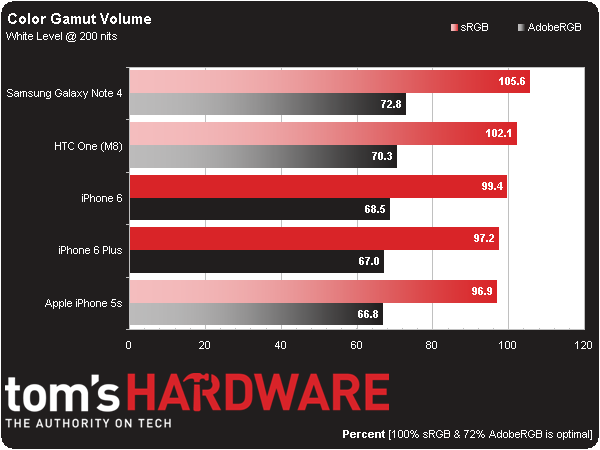

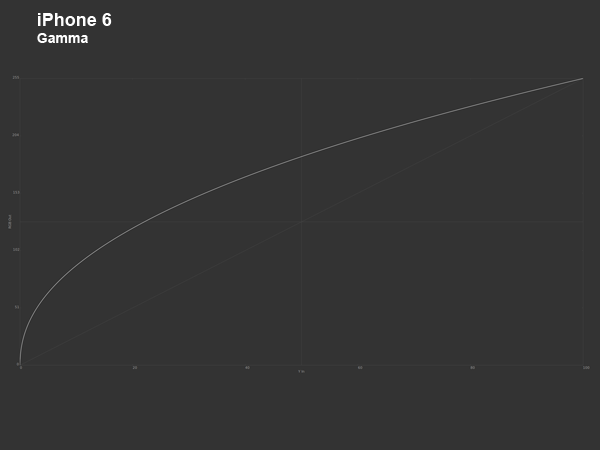
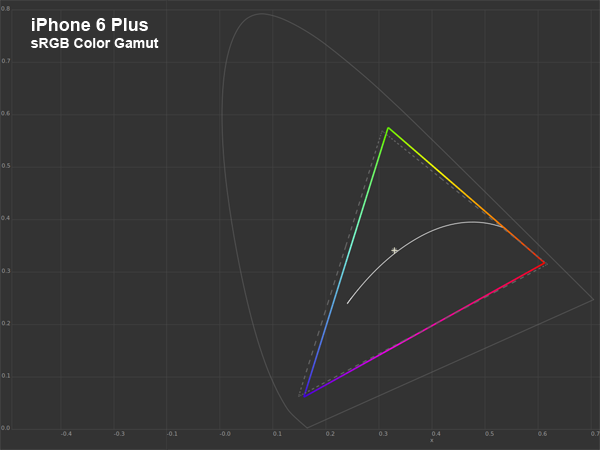
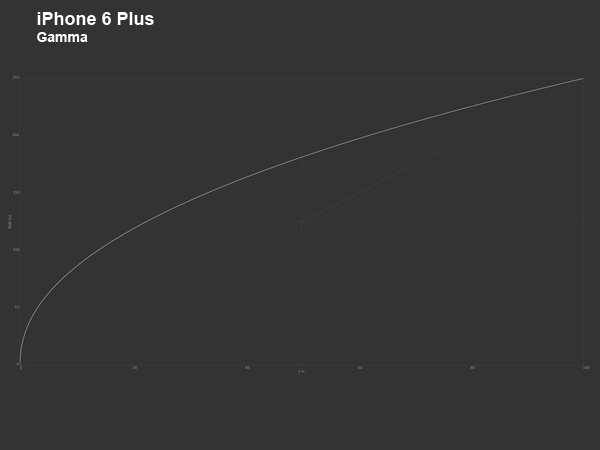
The SAMOLED screen in the Note 4 displays the widest color gamut, exceeding 100% of the sRGB color space. The iPhone 6 covers nearly the whole sRGB gamut, yielding a slight improvement over the 5s.
Current page: Test Results: Display Measurements
Prev Page Test Results: GPU Core Benchmarks Next Page Test Results: Battery And Throttling-
blackmagnum Everyone would want to own one and be the envy of their peers. They want a device that is attractive, well-made and intuitive. That's how Apple sells them by the millions, don't you agree?Reply -
lanbaner Nvidia has a better GPU. The G3 has a better display. The Note 4 has better camera. Gone are the days were the iPhone was the leader on all fronts. Would be nice to see all the strengths from the competition in one phone. Considering the transition to 20nm for Maxwell early next year we could possibly see an iPhonekiller on all aspects. Although I have to agree that the build quality on the iPhones is always top notch.Reply -
M3God Other then just sticking to just 1GB internal memory, there is no mention that apple switched to cheaper and slower TLC memory to make more profits while screwing the customer. The TLC memory has been linked to crashes and bootloops that require a trip to the apple store.Reply -
aaaas I browse the Web and talk on the phone on Verizon all the time. At least the last two generations of devices have been able to do this... at least for android...Reply
Interesting article, as I've been considering a switch to iphone. -
KaptainK " Wi-Fi calling is currently only supported by T-Mobile in the U.S."Reply
Not True! Republic Wireless has been using wi-fi calling for years. Republic also includes a feature where it will hand the call off from wi-fi to cellular if you leave the wi-fi zone during the call. Does the iPhone do this?? -
cknobman A. Thanks for including the Lumia 1520 in the comparison chart of phablets, most other sites dont do this.Reply
B. The price for the 6 plus in that same chart ($299) is on contract while every other device price is off contract.
As a whole if you are an iPhone user I am sure you are happy with the changes made to the 6. Outside of that the iPhone "cool factor" ship has sailed and this wont be winning over many Android users. -
cmi86 How can this guy sit here and hump apples leg by saying the A8 should be competitive if not class leading when it's competition averages over 1Ghz higher clock speed and 2 more cores.... I know a lot of people doing reviews now a days feel obligated to shine up certain companies and make their products appear in a positive light. This is not that... this is a blatant lie.Reply -
SirKnobsworth How can this guy sit here and hump apples leg by saying the A8 should be competitive if not class leading when it's competition averages over 1Ghz higher clock speed and 2 more cores.... I know a lot of people doing reviews now a days feel obligated to shine up certain companies and make their products appear in a positive light. This is not that... this is a blatant lie.Reply
Clock speeds and core counts can be deceptive, the key point here being that Apple's Cyclone cores can execute about twice as many instructions per clock cycle as most of their competitors. This shows up in the benchmarks - the iPhone 6 and 6+ do very well in single threaded tests, though tend to lag behind competitors in multithreaded tests like physics. Note that this is also the approach that Nvidia is taking with their Denver cores - fewer, bigger cores as opposed to more small cores.
How this translates into actual performance will vary of course - most smartphone workflows aren't particularly well threaded so having four cores as opposed to two probably won't make a huge difference in many situations, but I'm sure there are plenty of exceptions. -
ZXS ReplyDue to their zero reading on the black level tests, AMOLED displays are said to have an infinite contrast ratio.
MATT, do you know this is Samsung's marketing BS?
Smartphone displays reflect about 6% of incoming light (which is much more than LCD backlight emits). Actual contrast of AMOLED is worse than that of LCD since the reflections are so high, but maximum brightness is much lower than that of LCD.
